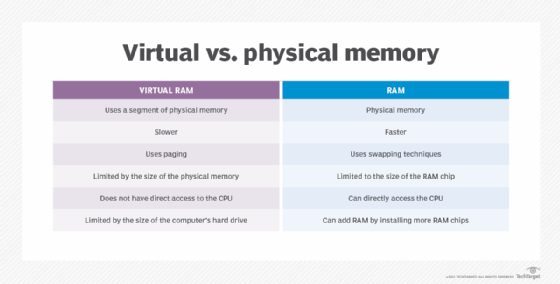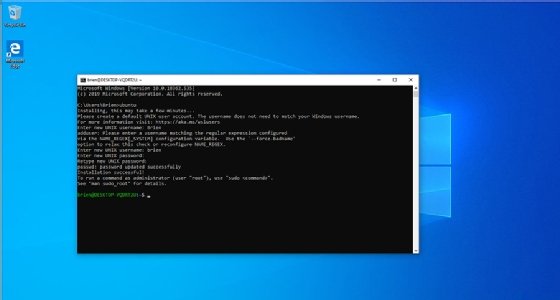How To Change Swap File Size In Windows 10
What is a swap file (swap space or page file)?
A swap file is a arrangement file that creates temporary storage space on a solid-state drive or hard disk when the system runs low on retentivity. The file swaps a section of RAM storage from an idle plan and frees up memory for other programs.
Past using a swap file, the computer can utilise more memory than is physically installed. In other words, it tin run more programs than it could run with merely the limited resources of the installed RAM.
Bandy files are not stored in physical RAM, which is why they are a blazon of virtual memory. Having a swap file allows a figurer'southward operating system (OS) to pretend that it has more RAM than it really does. The least recently used files or programs in RAM tin be "swapped out" to the hard disk until they're needed later, assuasive new files or programs to be "swapped in" to RAM.
The implementation of swap files varies with the Os, which takes care of creating and using a bandy file as required. It also releases the drive infinite when it is no longer required by a plan.
A swap file is too known as a folio file, swap space or paging file. It is hidden on the arrangement past default.

Why swap files are of import
Swap files play two important roles in estimator processing:
They can handle the extra load of memory consumption. Some applications swallow a huge corporeality of RAM, depriving other background applications that also need memory. Swap files help resolve this situation by paging out idle files to provide extra virtual memory.
Unforeseen circumstances. When a particular programme consumes extra memory, or when extra infinite is needed for device operations, swap files provide some breathing room until the user can come up with a more than permanent solution, such equally a RAM upgrade.
Benefits and drawbacks of swap files
While swap files aid extend physical retentivity and thus make it possible to run more programs, they can also lead to organization slowdowns. The file swaps out idle programs for in-utilize programs multiple times, which causes a lot of reading and writing on the system drive.
When the system starts using the bandy file on the bulldoze, operation may suffer because SSDs and hard disk drives (HDD) are much slower than RAM.
Temporary and permanent bandy files
Swap files tin be permanent or temporary. Operating systems such equally Windows tin can exist configured to utilise temporary swap files, while others such equally Unix and Linux can gear up bated a permanent swap space to create a permanent swap file.
Temporary bandy files usually use fragmented hd space. They don't permanently reserve function of the system hard disk drive, then they're more than useful if deejay space is limited.
Permanent swap files take a contiguous section of a hd. By organizing the swap file in a unmarried contiguous space, fewer I/O operations are required to read or write a complete file, so it doesn't affect system speed or operation as much as a temporary bandy file. However, permanent bandy files also take up more than disk space, and then if this space is already limited, they could wearisome down the organisation.
How to manage swap files in Windows ten
In Windows 10, bandy files or folio files are hidden with the .sys extension stored on the arrangement drive. The swapping process begins automatically whenever a user opens more applications than the RAM can conform.
Commonly, the minimum swap file size is 1.5 times the RAM chapters and the maximum is 4 times the RAM. For example:
RAM = ane gigabyte (GB)
Minimum bandy file = one.v GB
Maximum swap file = 4 GB
Windows 10 automatically manages the swap file co-ordinate to the system configuration and RAM. However, a user can also manually suit the swap file size if performance issues ascend.
The steps for manually adjusting Windows 10 swap files are:
- Right click on the Get-go icon in the system tray and click on Arrangement. (Note: The system ambassador business relationship should be used to log into Windows x.)
- Navigate to Advanced organization settings and click on the Avant-garde
- Click on the Settings push in the Operation section and navigate to the Advanced
- Click the Modify button and uncheck the Automatically manage paging file size for all drives checkbox
- Select the drive where Windows 10 is installed.
- Manually enter the maximum and minimum swap file size according to the physical retention present on the system.
- Click the Set push and then the OK button.
- Restart the computer.
Swap files in Linux
Linux has 2 types of swap space. One is the bandy sectionalization, a dedicated section or partition on the bulldoze. The second is the bandy file that resides among system and data files and is easy to resize.
With a bandy file, a separate partition is not required. Instead, the user merely creates a file under the root, which the organization then uses as the swap space.
To verify the swap infinite already bachelor on a Linux organisation, two commands can be used, either complimentary or swapon:
gratuitous control
Input: $ sudo complimentary –h
Output:
| full | used | free | shared | buff/cache | available | |
| Mem: | 488M | 158M | 80M | 2.1M | 246M | 220M |
| Swap: | one.0G | 506M | 520M |
If there'southward no bandy space on the system, the output of the free command could look like this:
| total | used | free | shared | buff/cache | bachelor | |
| Mem: | 488M | 158M | 80M | 2.1M | 246M | 220M |
| Swap: | 0G | 0G | 0G |
The gratis command shows the size of the swap space. However, it doesn't specify if the space is a swap partition or a swap file. For this, the swapon command is more useful
swapon command
Input: $ sudo swapon –bear witness
Output:
| NAME | Type | SIZE | USED | PRIO |
| /swapfile | file | 1024M | 500M | -i |
The swapon command cannot show any output if the system doesn't accept whatsoever swap space.

Creating a bandy file and making it bachelor in Linux
If the existing swap space is inadequate for system operations, a new bandy file can be created in Linux. The steps involved are:
- Create a bandy file with the mkfile command and specify the size of the bandy file in k (kilobytes), b (blocks) or one thousand (megabytes).
- Activate the swap file by using the swap command.
- Use the absolute path proper name to specify the swap file.
- To ensure that the swap file is activated automatically when the arrangement boots, specify the entry of swap file to the /etc/vfstab.
- Finally, verify if the bandy file is added.
A swap file in Linux can be created without root permissions. But to avoid accidental overwriting, the root should be the possessor of the swap file.
Removing a swap file in Linux
If a Linux bandy file is no longer needed, it can be removed using these steps with superuser access:
- Remove the swap space to remove the swap file name. This mode, the file will no longer exist available for swapping, although it will not exist deleted.
- Edit the /etc/vfstab file to delete the bandy file entry.
- Recover the disk space then it will be available for other use.
- Verify if the swap file is removed and no longer available.
Learn some tips to ameliorate Windows x operation and cheque out the differences betwixt Windows 10 and Windows 11 . Also, explore over 80 useful Linux commands , read upward on how to optimize Linux bandy space usage and observe out how memory pinch compares to page swapping.
How To Change Swap File Size In Windows 10,
Source: https://www.techtarget.com/searchwindowsserver/definition/swap-file-swap-space-or-pagefile
Posted by: sumrallcalim1942.blogspot.com


0 Response to "How To Change Swap File Size In Windows 10"
Post a Comment